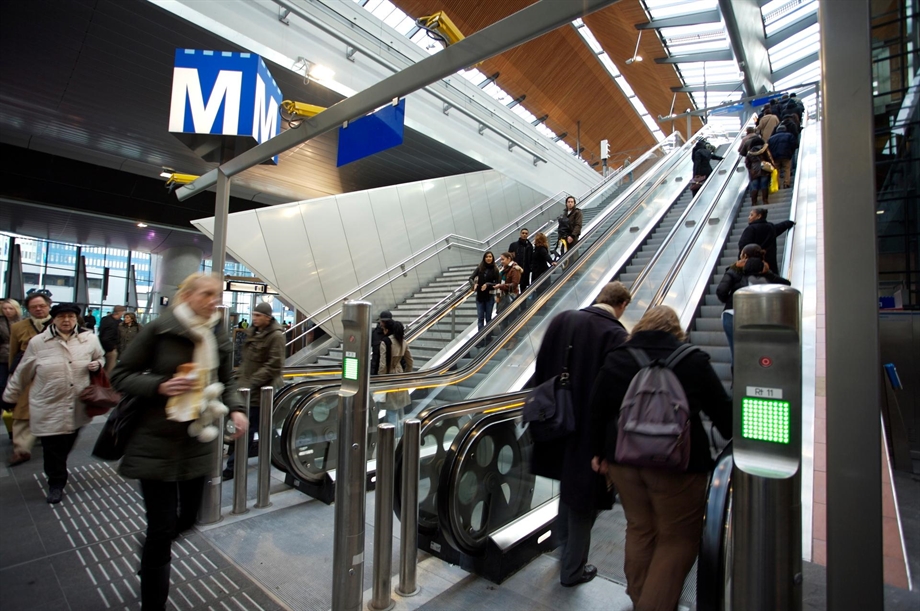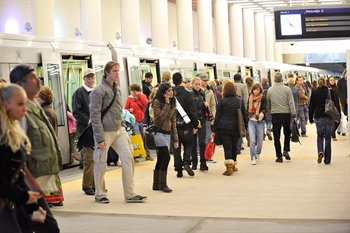Fact sheet Rush-hour avoidance on public transport
The rush-hour is unpleasant for passengers on public transport. As a result, public transport is less attractive than travelling by car. Offering small incentives for travelling at less busy times can help to create a more even distribution of passengers in and around rush-hour periods. As this will improve capacity utilisation, capacity increases will also be more profitable.
Several rush-hour avoidance projects have already been implemented on trains: by means of information, campaigns, discounts on public transport season tickets and financial incentives, passengers have been encouraged to travel after rush-hour periods, during quieter periods of the rush-hour, or to not travel. And due to lower costs it’s not just the provider who benefits from rush-hour avoidance. A better distribution of passengers over the day can also improve the level of comfort experienced by passengers.
Currently (autumn 2017), NS is focusing on extending the rush-hour period: in order to stimulate travel on busy routes just before or after peak times (between 6.30 and 7.00 a.m. and between 9.00 and 9.30 a.m.), passengers are rewarded if they travel just outside these times by means of apps (MyOV). If the rush-hour train is full, travellers are awarded zero points, whereas if they take the train immediately after that they get as many points as possible.
These points can be used to purchase rewards. For example, discounts on public transport season tickets or on food and drink at train stations. More information about this can be found in the case study Rush-hour avoidance on public transport via the MyOV app. As part of Optimising Use of Decentralised Railways (Beter Benutten Decentraal Spoor), experiments with the use of MyOV have also been conducted on a number of regional railway lines.
Accessibility effects
Rush-hour avoidance on public transport is a measure that has had relatively minor effect for the time being, due to the so far small number of participants. In practice, less than 1% of all passengers (on the targeted routes) are persuaded to avoid rush-hour journeys on public transport. This will probably not (yet) lead to a noticeable reduction in rush-hour passenger numbers on public transport. In the projects carried out so far, 0.1 - 0.7 rush-hour journeys on public transport have been avoided per active participant per day.
In 2008, research was conducted into the effect of a campaign to make passengers on the Haarlem - Amsterdam route aware of their choice to make a rush-hour journey. As a result of this information and campaign, 1% of passengers changed their travel behaviour. During a subsequent rush-hour avoidance project in 2009, it emerged that 125 (5%) of the registered customers holding season tickets for Utrecht to The Hague who were contacted were prepared to exchange their previous subscription for an off-peak season ticket at a 20% discount. They subsequently travelled almost exclusively in the off-peak period.

Research was also conducted into rush-hour avoidance on the train in 2013. In this practical test, in which 1,250 train commuters participated, the number of rush-hour journeys made by the participants decreased by 22%. Participants could earn up to €30 per week. In 2016 and 2017, a 13-week long rush-hour avoidance test took place on the route from Alkmaar to Sloterdijk. During this trial, 500 participants received an incentive (up to €10 per day) for avoiding rush-hour travel. The average percentage of rush-hour avoidance for participants in this trial was 35%, or 0.7 rush-hour journeys avoided per active participant per day: a significant effect, partly due to a relatively high incentive. 10% of this was achieved through not travelling and 25% through off-peak travel.
NS is currently (autumn 2017) deploying the MyOV app on all train routes around Utrecht Central Station and two other busy routes. The table below (1) shows the results for 6 routes around Utrecht Central Station on the basis of recent graduation research [1]. The MyOV app registers how often a person travels outside peak hours on routes where it is possible to receive an incentive. The figures show that the total project had more than 1,000 active participants at the time of the study, who collectively avoided more than 100 rush-hour journeys, split into 6 routes.
| Scope | Bandwidth based on 3 months | |
|---|---|---|
| Total number of journeys per day | 7,640 | 7,155-8,176 |
| Journeys on app routes per day | 4,447 | 3,314-5,317 |
| Participants | 5,754 | 5,307-6,566 |
| Active participants | 1,068 | 658-1,835 |
| ‘Rescheduled’ journeys (off-peak instead of rush-hour travel) per day | 115 | 79-175 |
| Rush-hour journeys avoided per active participant per day | 0.11 | 0.09-0.13 |
Meanwhile, there are already more than 10,000 participants (not all active participants). 70% of the participants are younger than 35. Almost half of the participants are frequent passengers who travel more than three times per week, mainly at peak times. Of the participants, 46% are commuters or travelling on business and 36% stated study as their reason for travel.
Long-term effects
The previously mentioned practical test in 2013 also included a re-measurement afterwards. During the incentive period, the participants achieved a 20% reduction in rush-hour journeys, compared to the original measurement. In the re-measurement period, four weeks after the incentive period and without reward, there was still a 6% reduction.
Variables with an impact on effects
A non-response survey conducted during the practical trial in 2013 showed that non-participants already travelled less frequently outside peak hours and were also less flexible in their working hours than participants. They would only make the same behavioural adjustments as the participants for much higher incentives (about four times as high) [2]. The level of incentive therefore has an effect on which people are interested in participating.
An all-or-nothing incentive (for which there is no reward without desirable behaviour) seems to result in the greatest change in behaviour [3]. Social and recreational passengers are the most motivated and are therefore a promising group to influence. Furthermore, students can also be considered as a separate target group which can be influenced. The route to which the measures are applied is also important. On routes where trains are full at peak times, there is a greater urgency for passengers to avoid these trains than on routes where seats are available at the same time of day.
Costs (including VAT)
Incentives of up to €10 per day were paid during previous public transport rush-hour avoidance pilots. More detailed information on compensation costs per rush-hour journey avoidance is available in relation to MyOV’s rush-hour extension projects. The cost of rush-hour avoidance depends on the route. On routes around Utrecht Central Station, rush-hour avoidance costs NS on average €4.09 (bandwidth €3.74 to €4.58). These are the total costs (project costs plus incentive costs).
And a study into the MyOV app was also carried out in the north of the Netherlands [4]. This study was done on the Zwolle - Emmen, Leeuwarden-Groningen, Leeuwarden-Harlingen, Leeuwarden-Stavoren, Groningen-Veendam, Groningen-Leer, Groningen-Roodeschool and Groningen-Delfzijl routes. In the four months that rush-hour avoidance was measured, the total costs amounted to €28,517. The measurements recorded 2,625 instances of rush-hour avoidance. So the average costs involved per rush-hour journey avoided in the north of the Netherlands amounted to €11.11 (bandwidth from €9.30 to €13.70, see table 2).
| Month | Licence fee | Registration bonus | MyOV journeys | Redeemed internally | Total | Rush-hour journeys avoided | Cost per rush-hour journey avoided |
|---|---|---|---|---|---|---|---|
| 2015-Oct | €6,000 | €782 | €744 | €88 | €7,438 | 543 | €13.70 |
| 2015-Nov | €6,000 | €336 | €929 | €130 | €7,135 | 739 | €9.66 |
| 2015-Dec | €6,000 | €317 | €874 | €129 | €7,061 | 759 | €9.30 |
| 2016-Jan | €6,000 | €168 | €810 | €94 | €6,883 | 584 | €11.79 |
| Total | €24,000 | €1,603 | €3,357 | €441 | €28,517 | 2625 | €11.11 |
The MyOV app costs consist of a fixed amount that is paid monthly from NS to Data-Lab, and a variable amount that depends on the number of rush-hour journeys avoided. As a result, the more often passengers reschedule their journeys, the lower the cost per rescheduled journey. New participants also receive a registration bonus (free points), so the costs also increase as the number of participants increases. The greater the number of routes on which points can be earned, the more passengers will participate. This allows greater flexibility, reducing the costs per rush-hour journey avoided.
More information
See https://wegwijs-beterbenutten.nl/spitsmijden-ov-onderwijs
Sources consulted
- Graduation research My OV bij NS (Thijs van Daalen, 2017)
- Spitsmijden in de trein: Gedragseffecten (VU, 2014) - https://www.rijksoverheid.nl/documenten/rapporten/2014/06/13/spitsmijden-in-de-trein-gedragseffecten
- Spitsmijden of het balanceren op het slappe koord tussen apathie en onderbouwde daadkracht (Rien van der Knaap & Ronald Kraus, 2009) - http://www.cvs-congres.nl/cvspdfdocs/cvs09_221.pdf
- MyOV beoordeling (MuConsult, 2016)
- Spitsmijden OV Zuid-Limburg (MuConsult, 2015)
- Rapport Effecten van belonen in Spitsmijden 2, hoofdstuk 5 over spitsmijden OV (2009)
Rules of thumb
- 0.1-0.7 rush-hour journeys avoided on public transport per active participant per day
- impact on sustainability: very limited effect on sustainability
- costs: €4-€11 per rush-hour jurney avoided

